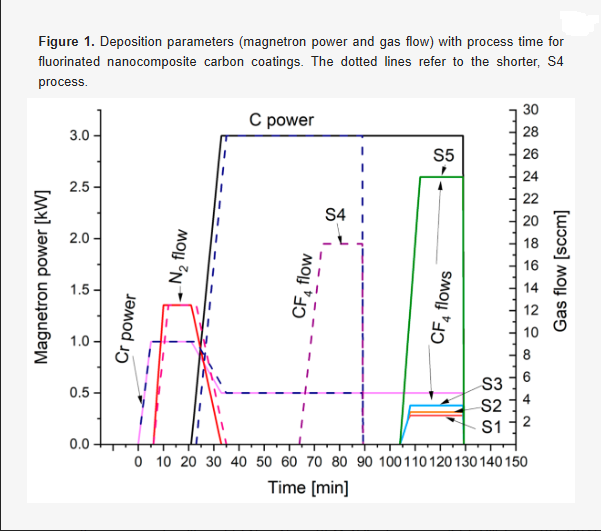Formation and Mechano-Chemical Properties of Chromium Fluorides Originated from the Deposition of Carbon-Chromium Nanocomposite Coatings in the Reactive Atmosphere (Ar + CF4) during Magnetron Sputtering
"Formation and Mechano-Chemical Properties of Chromium Fluorides Originated from the Deposition of Carbon-Chromium Nanocomposite Coatings in the Reactive Atmosphere (Ar + CF4) during Magnetron Sputtering"
The literature analysis did not indicate any studies on fluorination tests of carbon nanocomposite coatings doped with transition metals in a form of nanocrystalline metal carbide in amorphous carbon matrix (nc-MeC/a-C). As a model coating to investigate the effect of fluorination in a tetrafluoromethane (CF4) atmosphere, a nanocomposite carbon coating doped with chromium-forming nanocrystals of chromium carbides in a-C matrix (nc-CrC/a-C) produced by magnetron sputtering from graphite targets and using a Pulse-DC type medium frequency power supply was chosen. After the deposition of the gradient chromium carbonitride (CrCN) adhesive sublayer, the fluorination of the main coating was conducted in a reactive mode in an (Ar + CF4) atmosphere at various CF4 content. It was observed that the presence of CF4 in the atmosphere resulted in a reduced amount of chromium carbides formed in favor of chromium fluorides. Thus far, this is an observation that seems unnoticed by the carbon coatings researchers. Fluorine was assumed to bond much more readily to carbon than to chromium, due to the stability of tetrafluoromethane (CF4). The opposite seems to be true. The mechanical properties (nano-hardness and Young’s modulus) and tribological properties in the ‘pin-on-disc’ friction pair are presented, along with the analysis of bonds occurring between chromium, carbon, and fluorine by means of X-ray photoelectron spectroscopy (XPS).
Adam Roślak, Józef Doering, Wioletta Strzałka, Marcin Makówka, Łukasz Kołodziejczyk, Jacek Balcerzak, Anna Jędrzejczak, Łukasz Jóźwiak , Ireneusz Piwoński, and Wojciech Pawlak,
